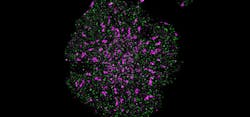Self-aligning microscope overcomes limits of superresolution microscopy
Medical researchers from the University of New South Wales (UNSW; Sydney, Australia) have achieved unprecedented resolution capabilities in single-molecule microscopy aimed at detecting interactions between individual molecules within intact cells.1
The 2014 Nobel Prize in Chemistry was awarded for the development of superresolution fluorescence microscopy technology that afforded microscopists the first molecular view inside cells, a capability that has provided new molecular perspectives on complex biological systems and processes. While individual molecules could be observed and tracked with superresolution microscopy already, interactions between these molecules occur at a scale at least four times smaller than that resolved by existing single-molecule microscopes.
“The reason why the localization precision of single-molecule microscopes is around 20 to 30 nm normally is because the microscope actually moves while we’re detecting that signal,” says Scientia Professor Katharina Gaus, research team leader and Head of UNSW Medicine’s EMBL Australia Node in Single Molecule Science. “This leads to an uncertainty. With the existing superresolution instruments, we can’t tell whether or not one protein is bound to another protein because the distance between them is shorter than the uncertainty of their positions.”
Three types of correction
To circumvent this problem, the UNSW team built autonomous feedback loops inside a single-molecule microscope that detects and realigns the optical path and stage, doing three-dimensional real-time drift corrections that achieve stabilization of better than 1 nm and localization precision of about 1 nm. Three types of correction were used: a feedback loop between the sample and stage position, an autonomous optical feedback loop in the emission path, and characterization and chromatic correction of the electron-multiplying CCD (EMCCD) camera to reduce the variation registered across the EMCCD by a factor of 10.
“It doesn’t matter what you do to this microscope, it basically finds its way back with precision under a nanometer,” Says Gaus. “It’s a smart microscope. It does all the things that an operator or a service engineer needs to do, and it does that 12 times per second.”
The feedback system designed by the UNSW team is compatible with existing microscopes and affords maximum flexibility for sample preparation.
To demonstrate the utility of the single-molecule microscope, the researchers used it to perform direct distance measurements between signaling proteins in T cells. A popular hypothesis in cellular immunology is that these immune cells remain in a resting state when the T cell receptor is next to another molecule that acts as a brake, but the microscope was able to show that these two signaling molecules are in fact further separated from each other in activated T cells, releasing the brake and switching on T cell receptor signaling.
“Conventional microscopy techniques would not be able to accurately measure such a small change as the distance between these signaling molecules in resting T cells and in activated T cells only differed by 4 to 7 nm,” says Gaus.
Source: https://newsroom.unsw.edu.au/news/science-tech/self-aligning-microscope-smashes-limits-super-resolution-microscopy
REFERENCE:
1. Simao Coelho et al., Science Advances, 7 April 2020, Vol. 6, No. 16, eaay8271; doi: 10.1126/sciadv.aay8271.
Got optics- and photonics-related news to share with us? Contact John Wallace, Senior Editor, Laser Focus World
Get more like this delivered right to your inbox
About the Author
John Wallace
Senior Technical Editor (1998-2022)
John Wallace was with Laser Focus World for nearly 25 years, retiring in late June 2022. He obtained a bachelor's degree in mechanical engineering and physics at Rutgers University and a master's in optical engineering at the University of Rochester. Before becoming an editor, John worked as an engineer at RCA, Exxon, Eastman Kodak, and GCA Corporation.

